About the Exhibition
Tokyo - Berlin / Berlin - Tokyo traces the
fascinating cultural links between these two great world capitals from
the end of the nineteenth century until the present day. Through two
world wars, a devastating earthquake, high-speed economic growth,
failed ideologies, and economic recessions, both cities experienced
similar periods of ruin and rebirth. Cultural contact between the two
capitals at these times was not limited to art, but included numerous
fascinating exchanges in such fields as architecture, photography,
theatre and design. This exhibit reflects the varied interaction and
traces their history in a total of some 500 works divided into 11
sections.
The first half of the exhibition showcases individual artists and
exhibitions that influenced Tokyo's artistic community in the early
twentieth century, including: Berlin architects Hermann Ende and
Wilhelm Böckmann, who designed the original Ministry of Justice
building (1887) in the Neo-Baroque style; the Der Sturm Gallery
exhibition (1914), which Yamada Kosaku, a composer and others brought
back to Japan from Berlin; Murayama Tomoyoshi, who created a sensation
when he helped found the MAVO group (1923) after absorbing such
influences as Russian avant-garde, Italian futurism, and Dadaism during
a stay in Europe; and the film and photography exhibition FIFO, which
had immense impact on the New Photography movement when it came to
Japan in 1931. Also included are Yamawaki Iwao and Mizutani Takehiko,
who studied at the Bauhaus, and Bruno Taut, one of the most important
architects in Berlin who spent three years in Japan in flight from the
Nazis in the 1930s. This part of the exhibition highlights these
individuals as it explores the relationship between Bauhaus and
Japanese architecture and design.
The second half of the exhibition focuses more on the parallel
relationships between the two cities and their artistic movements.
Works in this section start with the late 1930s,
when both nations were
on the brink of World War II and continues through war and its
accompanying defeat and the rebirth and reconstruction in the 1950s.
This is followed by the 1960s, when the New York-centered Fluxus
movement united avant-garde movements in Tokyo and Berlin, that then
grew and flowered together. Finally, the focus of the exhibition shifts
to Germany at the end of the Cold War. After the Berlin Wall was torn
down the city once again became the capital of a reunified Germany.
This revitalized Berlin has grown into a vibrant city capable of
sustaining its both history and traditions to produce fresh and dynamic
contemporary art.
Tokyo - Berlin / Berlin - Tokyo is one of the biggest events of the
Germany in Japan 2005/2006 festival, and will also tour to Germnay,
where it will be displayed at Berlin's Neue Nationalgalerie from June
2006.


Sections
- BERLIN-TOKYO 1880-1914 Exoticism and Modernity
- DER STURM IN TOKYO 1914 The Impact of the Avant-garde
- TOKYO-BERLIN 1912-1923 New Visions in Art and Architecture
- CULTURES IN CONFLICT 1918-1925 Berlin Dada, Tokyo MAVO and
the influence of the Russian Revolution
- MODERN GIRLS, MODERN BOYS Moga and Mobo in 1920s Tokyo and
Berlin
- FIFO (FILM UND FOTO) 1929-1931 New Approaches in Photography
- BAUHAUS AND BRUNO TAUT Design and Architecture in the 1930s
- THE DARK YEARS 1931-1945 Dictatorship, Resistance and War
- RECONSTRUCTION 1945-1950s The Aftermath of War
- FLUXUS, POP ART AND NEW EXPRESSIONISM IN THE 1960s
- BERLIN NOW Contemporary Art After the Wall

Artists
Franz ACKERMANN
AKAMATSU Rinsaku
AKASEGAWA Genpei
Josef ALBERS
AY-O
BAIDO Kunimasa (Utagawa Kunimasa IV)
Georg BASELITZ
Herbert BAYER
Max BECKMANN
Joseph BEUYS
Aenne BIERMANN
Wilhelm BÖCKMANN
Candice BREITZ
Marianne BRESLAUER
Marcel BREUER
Bunriha Kenchiku Kai (The Society of BUNRIHA Architects)
Max BURCHARTZ
David BURLIUK
Suse BYK
Chargesheimer
Lovis CORINTH
DOMON Ken
Ei-Q
Hermann ENDE
Annika ERIKSSON
Hans FINSLER
Arno FISCHER
Nina FISCHER & Maroan EL SANI
FUKUZAWA Ichiro
FUMON Gyo
Walter FUNKAT
FURUKAWA Narutoshi
FURUSAWA Iwami
Fred GRAVENHORST
Walter GROPIUS
Katharina GROSSE
George GROSZ
Hans GRUNDIG
HAHAKABE Kinshu
August HAJDUK
Heinz HAJEK-HALKE
HAMAMATSU Kogenta
HAMAYA Hiroshi
HANAYA Kanbee
HASEGAWA Kiyoshi
Raoul HAUSMANN
HAYASHI Tadahiko
John HEARTFIELD
Erich HECKEL
Florence HENRI
HIGUCHI Tadao
HIRAI Terushichi
Hannah HÖCH
Karl HOFER
HONJO Koro
HORINO Masao
ICHIYOSAI Kuniteru (Utagawa Kuniteru II)
IKEBE Hitoshi
INOUE Yasuji
ISHII Shigeo
ISHIMOTO Kikuji
IWAMIYA Takeji
Julius JACOB
Jikken kobo (HASEGAWA Saburo, KITADAI Shozo, OTSUJI Kiyoji, SAITO
Yoshishige, TESHIGAHARA Sofu, YAMAGUCHI Katsuhiro)
KAGEYAMA Koyo
KANBARA Tai
Wassily KANDINSKY
KATSUKAWA Shuntei
KAWABATA Ryushi
KAWABE Masahisa
KAWAKAMI Ryoka
KAWARA On
Peter KEETMAN
Keiji Kobo
KIMURA Ihee
Ernst Ludwig KIRCHNER
KISHIDA Ryusei
KOBAYASHI Mango
KOGA Harue
KOISHI Kiyoshi
Oskar KOKOSCHKA
Georg KOLBE
Käthe KOLLWITZ
KON Wajiro
KOSUGI Takehisa
KUDO Tetsumi
KUSAMA Yayoi
KUWABARA Kineo
Martin LIEBSCHER
Wassili LUCKHARDT
MACHIDA Ryuyo
Jeanne MAMMEN
Franz MARC
Elli MARCUS
Ludwig MEIDNER
Erich MENDELSOHN
Adolph von MENZEL
Harald METZKES
Ludwig MIES van der ROHE
Boris MIKHAILOV
MISE Koichi
MIZUTANI Takehiko
László MOHOLY-NAGY
Wilhelm MORGNER
MOROOKA Koji
MURAYAMA Tomoyoshi
Hermann MUTHESIUS
NAGANO Shigeichi
NAGANO Yoshimitsu
NAKAHARA Minoru
NAKAMURA Kenichi
NAKANISHI Natsuyuki
NAKAYAMA Iwata
NAMBA Kakuzo
NATORI Yonosuke
Ernst Wilhelm NAY
Oscar NERLINGER
Emil NOLDE
OKAMOTO Taro
OKUBO Koroku
ONCHI Koshiro
Emil ORLIK
Nam June PAIK
Victor PALMOV
Max PECHSTEIN
Walter PETERHANS
Hans POELZIG
Albert RENGER−PATZSCH
Daniel RICHTER
Werner ROHDE
Willy RÖMER
Hajo ROSE
Charlotte RUDOLPH
Fritz RUMPF
SAEKI Shunko
SAWADA Tetsuro
Christian SCHAD
Karl SCHMIDT-ROTTLUFF
Eugen SCHÖNEBECK
Kurt SCHWITTERS
Friedrich SEIDENSTÜCKER
SHIOMI Mieko
SHIRATAKI Ikunosuke
Otto STEINERT
Jakob STEINHARDT
Gunta STÖLZL
Sasha STONE
Horst STREMPEL
SUGIURA Hisui
SUMIYA Iwane
TAKAMATSU Jiro
TAKIZAWA Mayumi
TAMAMURA Hokuto
Georg TAPPERT
Tiger TATEISHI
Bruno TAUT
Max TAUT
Frank THIEL
TOGO Seiji
TSUCHIURA Kameki
TSUDA Seifu
TSUMAKI Yorinaka
Umbo (Otto UMBEHRS)
Wolf VOSTELL
WADACHI Tomoo
WATANABE Yuzuru
William WAUER
Jupp WIERTZ
Emmett WILLIAMS
YAMADA Mamoru
YAMAGUCHI (OKAMURA) Bunzo
YAMASHITA Kikuji
YAMAWAKI Iwao
YANASE Masamu
YOKOO Tadanori
YOROZU Tetsugoro
YOSHU Chikanobu
Yva
*Alphabetical Order

Mori Art Museum Podcast (BETA)
| Take an audio tour of Tokyo-Berlin / Berlin-Tokyo by exhibition
curator and Museum Director David Elliott. Podcasting file available here: |

Drag & drop this banner to your iTunes.
|

Supplementary English Translations of Catalog Texts
Below are English translations of some of the texts that appear in Japanese in the catalog for Tokyo-Berlin / Berlin-Tokyo.
Tokyo-Berlin / Berlin-Tokyo: a continuing dialog of modern cities, by David Elliott and Peter-Klaus Schuster
Appears in Japanese on p13 to p20 of the catalog and in English on p318 to p324
Berlin-Tokyo: Expressionism in Film,
by Donald Richie
Appears in Japanese on p59 to p61 of the catalog.
The Daughter of the Samurai, 1937: a
German-Japanese co-production, by Donald Richie
Appears in Japanese on p62 to p63 of the catalog.
Architecture: The
Berlin-Tokyo connection from the late 19th century until the late 1920s,
by Andres Lepik and Iride Rosa
Appears on p118 to p119 of the catalog.
Modern Girls: New figures in a consumer age,
by Barbara Sato
Appears on p170 to p171 of the catalog.
The
Dark Years: 1931-1945, by David Elliott
Appears in Japanese on p228 to p245 of the catalog.
The
New Japan, by David Elliott
Appears in Japanese on p250 to p251 of the catalog.
Tokyo-Berlin Exhibition Poster Receives Major International Design Award
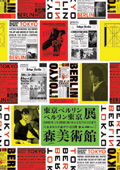 It was recently announced that the poster for the Tokyo-Berlin / Berlin-Tokyo exhibition received a Gold award in the One Show Design category of New York-based design competition The One Show. The competition is held annually, and this year over 1800 entries were received from over 30 countries in the One Show Design category. The Tokyo-Berlin / Berlin-Tokyo poster was the only entry from Japan to be honored with a Gold award. It was recently announced that the poster for the Tokyo-Berlin / Berlin-Tokyo exhibition received a Gold award in the One Show Design category of New York-based design competition The One Show. The competition is held annually, and this year over 1800 entries were received from over 30 countries in the One Show Design category. The Tokyo-Berlin / Berlin-Tokyo poster was the only entry from Japan to be honored with a Gold award.
The poster was designed by Tokyo-based design company Good Design Company. The art director was Manabu Mizuno.
The poster is currently being displayed on The One Show website:
http://www.oneclub.org/oneshow/osd_awards.php?id=969
The One Show
The One Show was established over 30 years ago and, along with the Cannes Lions International Advertising Festival and the Clio Awards, is considered one of the three most important advertising prizes in the world. It is judged each year by a jury of international design specialists.

|
 |
| MAM
SCREEN each month presents a video work related to an exhibition
currently on at the Mori Art Museum. The work is shown at several
screens throughout Roppongi Hills, such as the 500 inch outdoor screen
of Metro Hat and PDP monitors in West Walk. |
 |
| The work by Berlin-based
artists participating in Tokyo - Berlin / Berlin - Tokyo will be
screened until April 2006. |
 |
Jan
Martin Liebscher
Sharing a Ride
2004 |
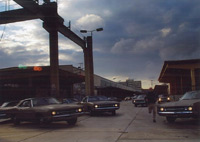 |
Feb
Annika Eriksson
People in Public Spaces
2000-2006
*It will be screened at the 500 inch outdoor screen of Metro Hat from 17:00 everyday. |
 |
Mar
Candice Breitz + Alexander Fahl
Thriller
2005
Courtesy: Bifrons Foundation |
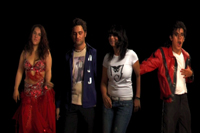 |
Apr
Nina Fischer & Maroan el Sani
Berlin (sunrise) - 10 sec thinking about the future
2000
Courtesy: Galerie EIGEN + ART Leipzig / Berlin and the artists |
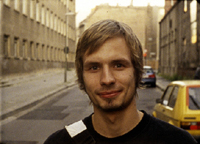 |
|
|
 |

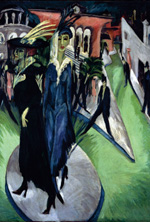
Ernst Ludwig Kirchner Potsdamer Platz in Berlin
1914 Oil on Canvas 200 x 150cm
Collection: Staatliche Museen zu Berlin, Nationalgalerie, (Inv. No. NG
7/99)
(c) (for works by E.L.Kirchner) by Ingeborg & Dr. Wolfgang
Henze-Ketterer, Wichtrach / Bern

Max Beckmann
Tod / Death
1938 Oil on Canvas
121 x 176.5cm
Collection: Staatliche Museen zu Berlin, Nationalgalerie (Inv.No. B 80)
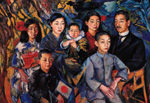
David Burliuk
Portrait of a Family
1921 Oil on Canvas
94.2 x 136.4cm
Collection: Hyogo Prefectural Museum of Art

Martin Liebscher
Philharmonie 1
2005 125cm x 740cm
Lambda print Sammlung Claudia and Kurt V. Storch
Courtesy: Wohnmaschine, Berlin
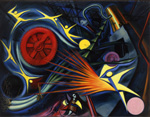
Okamoto Taro
Heavy Industry
1949
Oil on Canvas
206.3 x 266.7cm
Collection: Taro Okamoto Museum of Art, Kawasaki, Kanagawa
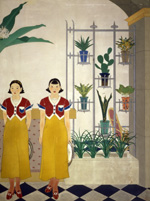
Saeki Shunko
Tea Room
1936 Color on Paper
264 x 197cm
Private Collection, U.S.A
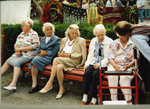
Boris Mikhailov
In the Street
2001/03 150 x 100cm
Type C-Print
Courtesy: Galerie Barbara Weiss, Berlin
Photo: Jeus Ziehe, Berlin
|

 It was recently announced that the poster for the Tokyo-Berlin / Berlin-Tokyo exhibition received a Gold award in the One Show Design category of New York-based design competition The One Show. The competition is held annually, and this year over 1800 entries were received from over 30 countries in the One Show Design category. The Tokyo-Berlin / Berlin-Tokyo poster was the only entry from Japan to be honored with a Gold award.
It was recently announced that the poster for the Tokyo-Berlin / Berlin-Tokyo exhibition received a Gold award in the One Show Design category of New York-based design competition The One Show. The competition is held annually, and this year over 1800 entries were received from over 30 countries in the One Show Design category. The Tokyo-Berlin / Berlin-Tokyo poster was the only entry from Japan to be honored with a Gold award.









